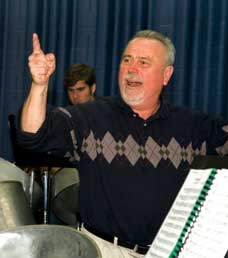Interview
On A Roll
UGA musicology graduate student Elizabeth Whittenburg talks with percussion professor Thomas W. (Tony) McCutchen about his love for steel drums—and how studying steel-drum music in Trinidad has influenced his teaching and bandleading here at home.
Q: How would you describe the University of Georgia’s Tropical Breeze Steel Band?
A: It is a performing ensemble comprised of instruments made from 55-gallon steel drums, which cover all the voices from soprano through bass, and a full rhythm section. The band does music from Trinidad and other Latin countries, along with classical, pop, and jazz.
 The Steel Band is a musical ambassador for the university, performing at various events such as concerts at public schools, college campuses, festivals, and conferences—the Percussive Arts Society International Convention, for example.
The Steel Band is a musical ambassador for the university, performing at various events such as concerts at public schools, college campuses, festivals, and conferences—the Percussive Arts Society International Convention, for example.
Q: What kindled your interest in steel-drum music?
A: I heard my first steel band at a 1982 percussion convention in Dallas, Texas. The University of North Texas Steel Band performed, and soloist Andy Narell presented a clinic. I was naive about the art form but captivated by the sound, and I wanted my students to share in this experience of playing in what amounted to a percussion orchestra. When one sees and hears a steel drum, it almost seems magical in that the sound is coming from what used to be a container for liquids.
Within a year, I purchased my own steel drum (also called a pan), and in 1986 I founded the steel-drum ensemble at UGA. Little information about steel drums was readily available at that time, so I learned on my own by intuition, experimentation, listening to recordings, reading articles, and attending steel-drum clinics.
I knew that I wanted to visit Trinidad because the steel drum was born there and is the country’s national instrument. My first trip to Trinidad was in 2005, when I attended an annual steel-band competition called Panorama—an astounding event. A university steel band in the U.S. may have 10-20 players, whereas a large steel band in Trinidad may have 75 or 100. The sheer volume and mass of sound from so many instruments played simultaneously is incredible. You feel it as well as hear it. A steel band is like an orchestra—adding instruments not only makes it louder but also changes the sound, just as a solo violin has a particular sound and an orchestra with many strings has a different sound.
These bands are a perfect example of community bands, as they are often organized by villages. Performers are not full-time musicians, and the vast majority of them do not read music. Another interesting thing to observe is how Trinidadians discuss steel bands. They know the names of the bands and their arrangers, and they talk about them in the same way that Americans discuss football or baseball teams. This music is a true source of pride that represents their culture. Steel drums are one of the few instruments invented in the past century, and they are Trinidad’s musical gift to the world.
Q: Have your observations in Trinidad changed how UGA’s steel-drum ensemble operates?
A: I try to make my students aware of what I have learned about this art form, so knowing how Trinidadians play certainly influences what we do and how we do it. But we don’t want everything we do to be similar to what I observed in Trinidad because our conditions in Georgia are culturally and educationally different. And while I try to make sure that my students have an understanding and appreciation of the original art form and how it is practiced today, I also want them to know that we are taking it a step further in development of styles and repertoire.
Q: How has your study of steel drums influenced your teaching philosophy?
A: It has definitely made my teaching philosophy more inclusive of multicultural elements and styles of music. Since becoming involved with pan, I have become more aware of and interested in all types of Latin music. I continue to teach jazz, which I’ve loved since my undergraduate days, but now I also teach and direct the Salsa Band and include some Brazilian musical concepts and styles in my teaching.
Within the context of steel band, my students learn—in a practical and firsthand manner—a variety of musical concepts involving harmony, form, improvisation, and rhythmic styles. The steel drum is a particularly valuable part of our percussion students’ education; the ensemble is primarily staffed by percussion majors in the school of music. We also have non-percussion music majors in the band and some non-music-major student participants. This is not a class for the casual student, however. I tell students that they must make a commitment to learn the instrument, practice after class, and participate for at least one year. If they do this, they will likely stick with the ensemble until they graduate. Currently there are 15 students in the upper-level group and 10 students in the beginner/intermediate group. The beginner group makes our advanced band stronger because the first ensemble allows students to improve at an appropriate pace.
Former students often tell me that steel band is the one thing they miss the most about UGA after graduation. I’m happy to be a part of those memories.
For more information about UGA’s Tropical Breeze Steel Band and other music programs, visit the School of Music website at: www.music.uga.edu/
 |


